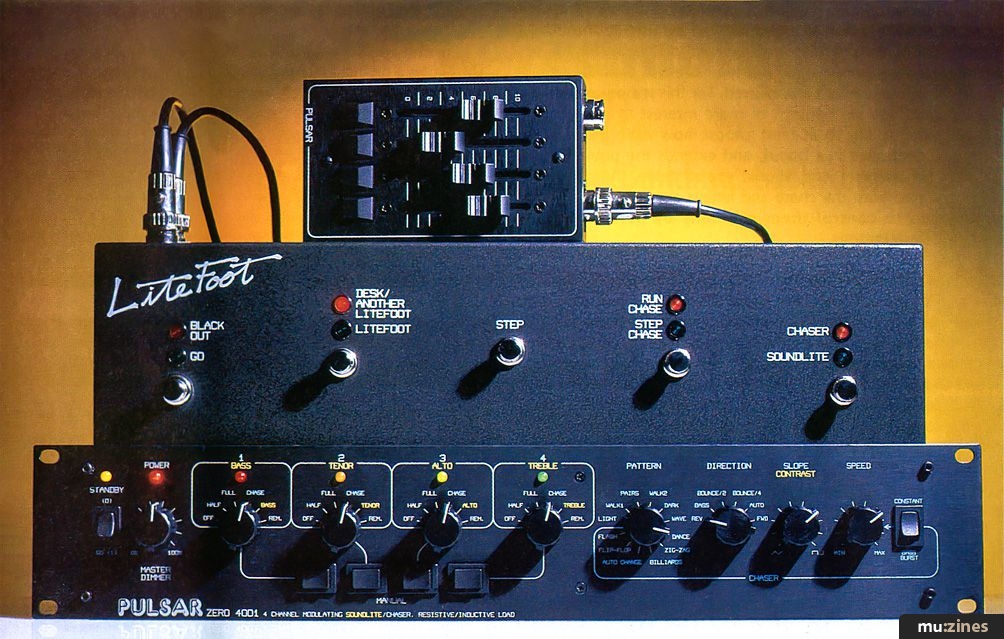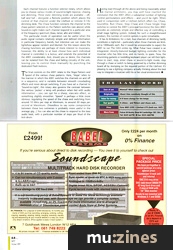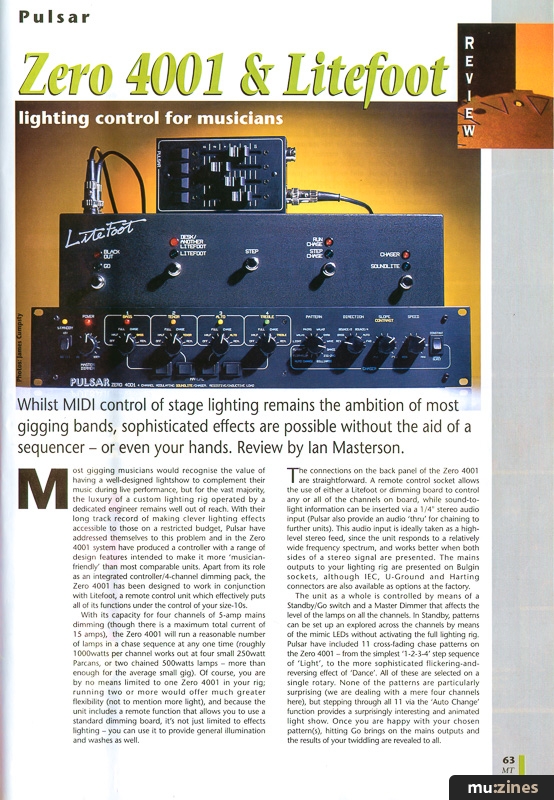Magazine Archive
Home -> Magazines -> Issues -> Articles in this issue -> View
Article Group: | |
Pulsar Zero 4001 & Litefoot | |
lighting control for musiciansArticle from Music Technology, March 1994 | |
Look - no hands! Play and display even without MIDI.
Whilst MIDI control of stage lighting remains the ambition of most gigging bands, sophisticated effects are possible without the aid of a sequencer - or even your hands.

Most gigging musicians would recognise the value of having a well-designed lightshow to complement their music during live performance, but for the vast majority, the luxury of a custom lighting rig operated by a dedicated engineer remains well out of reach. With their long track record of making clever lighting effects accessible to those on a restricted budget, Pulsar have addressed themselves to this problem and in the Zero 4001 system have produced a controller with a range of design features intended to make it more 'musician-friendly' than most comparable units. Apart from its role as an integrated controller/4-channel dimming pack, the Zero 4001 has been designed to work in conjunction with Litefoot, a remote control unit which effectively puts all of its functions under the control of your size-10s.
With its capacity for four channels of 5-amp mains dimming (though there is a maximum total current of 15 amps), the Zero 4001 will run a reasonable number of lamps in a chase sequence at any one time (roughly 1000watts per channel works out at four small 250watt Parcans, or two chained 500watts lamps - more than enough for the average small gig). Of course, you are by no means limited to one Zero 4001 in your rig; running two or more would offer much greater flexibility (not to mention more light), and because the unit includes a remote function that allows you to use a standard dimming board, it's not just limited to effects lighting - you can use it to provide general illumination and washes as well.
The connections on the back panel of the Zero 4001 are straightforward. A remote control socket allows the use of either a Litefoot or dimming board to control any or all of the channels on board, while sound-to-light information can be inserted via a 1/4" stereo audio input (Pulsar also provide an audio 'thru' for chaining to further units). This audio input is ideally taken as a high-level stereo feed, since the unit responds to a relatively wide frequency spectrum, and works better when both sides of a stereo signal are presented. The mains outputs to your lighting rig are presented on Bulgin sockets, although IEC, U-Ground and Harting connectors are also available as options at the factory.
The unit as a whole is controlled by means of a Standby/Go switch and a Master Dimmer that affects the level of the lamps on all the channels. In Standby, patterns can be set up an explored across the channels by means of the mimic LEDs without activating the full lighting rig. Pulsar have included 11 cross-fading chase patterns on the Zero 4001 - from the simplest '1-2-3-4' step sequence of 'Light', to the more sophisticated flickering-and-reversing effect of 'Dance'. All of these are selected on a single rotary. None of the patterns are particularly surprising (we are dealing with a mere four channels here), but stepping through all 11 via the 'Auto Change' function provides a surprisingly interesting and animated light show. Once you are happy with your chosen pattern(s), hitting Co brings on the mains outputs and the results of your twiddling are revealed to all.
Each channel features a function selector rotary, which allows you to choose various modes of sound-to-light response, chasing and dimming. Three static dimming levels are available - off, half and full - alongside a Remote position which places the control of that channel under the Litefoot or remote 0-10v dimming desk. The Chase function connects the channel to the chase pattern selected on the Pattern switches (see above) while Sound-to-Light makes each channel respond to a particular area of the frequency spectrum (bass, tenor, alto and treble).
This particular mode of operation can be useful when the audio signal contains relatively simple and defined information in particular frequency bands, but intensive use can make the lightshow appear random and blurred. For this reason alone the chasing functions are perhaps of more interest to musicians; however, the ability to at least choose how each individual channel is controlled is a bonus, and extends the potential of the 4001 considerably. And, should you so desire, the channels can be isolated from the chase and fading circuitry of the unit, leaving you to control them manually by punching the dedicated Flash buttons.
The final controls on the 4001 relate to the Slope Pattern and Speed of the various chase patterns. Here, 'Slope' refers to the manner in which the 4001 switches the channels on and off in a sequence, and is variable between smooth crossfading effects and more abrupt switching. If you have set a channel to 'Sound-to-Light', this rotary also governs the contrast between the various 'pulses' a lamp will produce when fed with audio information - you can opt for a sharp, staccato effect, or something slightly smoother. 'Speed' is perhaps a little more obvious, regulating the speed of the chase and switching from around 10 Mins per step at Minimum, to around 50 steps per second at Maximum. (Needless to say some compromise between these two extremes is probably more useful in the average gig...) You can also set the chase to respond to the bass audio beat, with a particular number of steps per thud of the kick drum.
Having read through all the above and being reasonably adept at mental arithmetic, you may well have reached the conclusion that the 4001 offers a substantial number of lighting control permutations and effects - and you'd be right. When used in conjunction with a Litefoot (which offers Go, Chase, Soundlite, Run Chase, Step Chase and Chase Single Step switches to control the 4001's principal functions) the Zero 4001 provides an extremely simple and effective way of controlling a small stage lighting system. Indeed, for such a straightforward product, the number of control options is quite remarkable.
It has its limitations; for a start, four channels of dimming hardly constitutes a nightclub - particularly when those channels are limited to 1000watts each. But it would be unreasonable to expect the 4001 to run The Orb's entire rig. What Pulsar have created is an integrated, cleverly-featured budget lighting controller for the musician who has little time, and no hands, to spare. Now, the strumming guitarist or twiddling keyboard player can tell their light-show to start, stop, enter chase or sound-to-light mode, step through a chase or switch to being governed by a further dimming board all by stomping on the required portion of the LiteFoot. It's pleasing to see a lighting company actually thinking about the best way to integrate a musician with his or her visual environment.
THE LAST WORD
| Ease of use | Manual? What manual? |
| Originality | About time somebody thought of this |
| Value for money | It'll leave change for the lamps |
| Star Quality | It shines - and flickers and chases and... |
| Price | Zero 4001 £295, Litefoot £79 (both exc. VAT) |
| More from | Pulsar, (Contact Details) |
Publisher: Music Technology - Music Maker Publications (UK), Future Publishing.
The current copyright owner/s of this content may differ from the originally published copyright notice.
More details on copyright ownership...
Quality Control
Gear in this article:
Review by Ian Masterson
Help Support The Things You Love
mu:zines is the result of thousands of hours of effort, and will require many thousands more going forward to reach our goals of getting all this content online.
If you value this resource, you can support this project - it really helps!
Donations for November 2025
Issues donated this month: 0
New issues that have been donated or scanned for us this month.
Funds donated this month: £0.00
All donations and support are gratefully appreciated - thank you.
Magazines Needed - Can You Help?
Do you have any of these magazine issues?
If so, and you can donate, lend or scan them to help complete our archive, please get in touch via the Contribute page - thanks!






